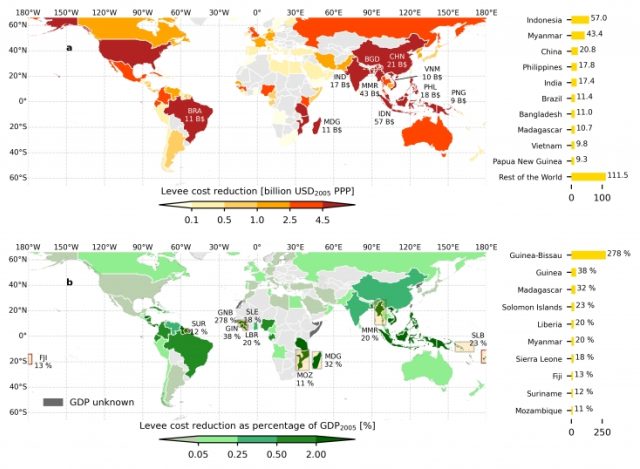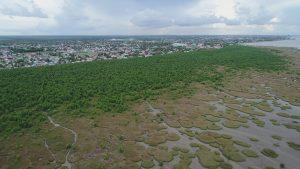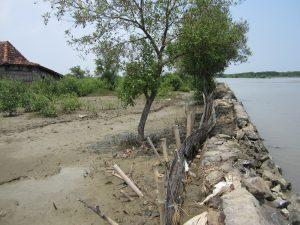Coastal vegetated ecosystems essential for keeping coastal protection affordable in low income countries
Using satellite data and numerical modelling, researchers from Deltares together with TU Delft, IVM and University of Cádiz globally assessed current coastal vegetation width and wave reduction. Resulting levee crest heights were assessed and monetized indicating that globally vegetation presence can yield a potential reduction in costs for construction of coastal infrastructure of 320 billion USD. The results of the global study were published this week in the journal Nature Communications.

Wave-vegetation interaction reduces incoming wave height
18.5 % of global coastlines are covered by salt marsh or mangrove vegetation. These ecosystems play a buffering role by reducing impacts of waves. For 11.5 % of global coastlines, coastal vegetation reduces incoming waves by more than 25 %. Next to coastal flood protection, coastal ecosystems provide other ecosystem services such as carbon storage, improved water quality and habitat for fish. However, the overall extent of these coastal ecosystems is decreasing globally, due to both natural and anthropogenic drivers, such as sea level rise and urbanization. This trend negatively impacts the benefits delivered by mangroves and salt marsh systems.
Lower levees while maintaining the same protection standard
First author of the study Vincent van Zelst of Deltares explains: “Although, coastal vegetation belts cannot fully prevent flooding, levees without protective vegetation in front require larger dimensions and investments compared to levees with intertidal vegetation present seawards. Accounting for vegetation that is fronting levees allows lower levee design heights to achieve the same level of safety. These hybrid designs with vegetation and seawalls or levees combine the best of both worlds, ecology and engineering and are a promising way forward.” The study illustrates that for 21.8 % of the global coastlines that are populated and exposed to coastal flooding, accounting for vegetation lowers the design levee crest height by more than 50 centimeters for a 1 in 100 years storm. For future levees this results in reduced coastal protection investments. This also applies to existing levees, as potential levee heightening, e.g. due to projected sea-level rise, may not be necessary.
Opportunities for hybrid solutions all around the globe
The difference in the design levee crest heights with and without protective vegetation are also monetized and globally this yields a potential reduction in costs of 320 billion USD (of which 67.5 billion USD in urban areas). The study shows potential locations in all five continents but highlights the overall potential in Asia (e.g. Indonesia, Myanmar, China, Philippines) where large mangrove areas are still present.
Co-author Dr. Bregje van Wesenbeeck of Deltares and TU Delft, states: “In these countries, conservation of these ecosystems is essential to remain future coastline stability and to reduce costs for coastal management. Levees, sea-walls and other hard infrastructure are regularly found in positions that negatively influence coastal resilience, by reducing flows of sediment, nutrients, fresh water and species, and by blocking landward migration of vegetation under sea level rise. We stress that local system understanding is required for correct design, implementation and management of Nature-based Solutions. The current study provides a global overview and is meant to stimulate local assessments and initiatives in locations with high potential for including coastal vegetation."
Nature-based Solutions for disaster risk reduction and climate adaptation
The current study shows that integrating coastal vegetation in coastal protection strategies can substantially reduce coastal protection costs. The buffering capacity of coastal vegetation is crucial for rural coastlines where conventional protection by hard infrastructure alone is socioeconomically unfeasible and undesirable. In this light, the results could be interpreted as a warning not to remove coastal vegetation and manage these areas in a sustainable manner. Formal integration of coastal vegetation with infrastructure design combined with sustainable coastal zone management is a cost-effective and sustainable approach for maintaining many global coastal areas. Has the time come for cutting the costs instead of cutting coastal vegetation?


-------------------------------------
Van Zelst, V.T.M., Dijkstra, J. T., Van Wesenbeeck, B. K., Eilander, D., Morris, E. P., Winsemius, H. C., Ward, P. J., De Vries, M. B. Cutting the costs of coastal protection by integrating vegetation in flood defences. Nature Communications (2021). https://doi.org/10.1038/s41467-021-26887-4


